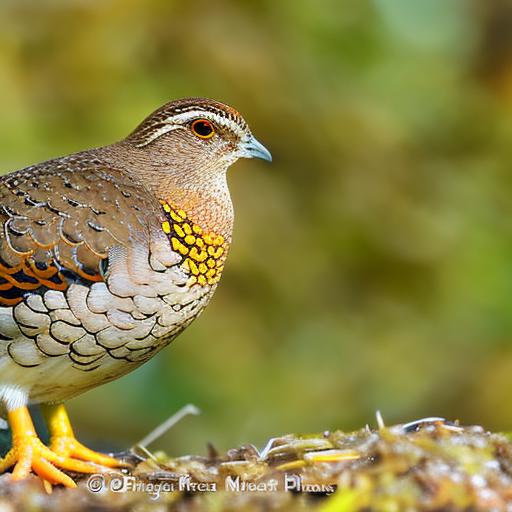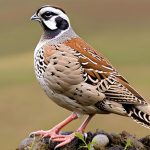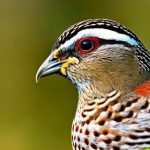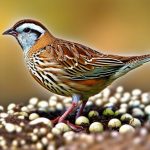Button quail, also known as Chinese painted quail, are small, ground-dwelling birds that are native to Southeast Asia. They are popular among avian enthusiasts for their small size, colorful plumage, and interesting behaviors. Button quail are often kept as pets due to their low maintenance requirements and entertaining personalities. These birds are known for their active nature and can be a joy to watch as they forage and explore their environment. Button quail are also relatively quiet birds, making them suitable for apartment living or for those who prefer a peaceful avian companion. With the right care and attention, button quail can live up to 5 years in captivity, making them a long-term commitment for potential owners.
Button quail come in a variety of color mutations, including silver, cinnamon, and pearl. Their small size, typically around 4 inches in length, makes them an attractive option for those with limited space. These birds are also known for their ability to fly short distances, so it’s important to provide them with a secure enclosure to prevent escape. Button quail are social animals and are best kept in pairs or small groups to prevent loneliness and encourage natural behaviors. Overall, button quail make fascinating and rewarding pets for those willing to provide them with the proper care and attention.
Key Takeaways
- Button quail are small, ground-dwelling birds that make unique and interesting pets.
- They require a specialized enclosure with proper substrate and hiding spots to thrive in captivity.
- A balanced diet of seeds, insects, and greens is essential for the health and well-being of button quail.
- Regular veterinary check-ups and a clean living environment are crucial for preventing health issues.
- Breeding button quail requires careful monitoring of nesting behavior and providing the right conditions for successful reproduction.
Housing and Enclosure Requirements
When it comes to housing button quail, it’s important to provide them with a secure and spacious enclosure that meets their specific needs. A suitable enclosure for button quail should be at least 24 inches long and 12 inches wide, with a height of at least 12 inches. This will give them enough space to move around and engage in natural behaviors such as foraging and dust bathing. The enclosure should also have a solid bottom to prevent injury to their delicate feet and legs.
It’s important to provide a substrate in the enclosure that mimics their natural habitat, such as sand or fine gravel. This will allow the button quail to engage in dust bathing, which helps to keep their feathers clean and free of parasites. Additionally, providing hiding spots and low perches will give the quail a sense of security and enrichment. It’s important to ensure that the enclosure has good ventilation to prevent the buildup of ammonia from their droppings. Regular cleaning and maintenance of the enclosure are essential to keep the quail healthy and happy.
In addition to a suitable indoor enclosure, button quail can also benefit from access to an outdoor aviary, weather permitting. This will allow them to experience natural sunlight and fresh air, which can have positive effects on their overall well-being. However, it’s important to ensure that the outdoor aviary is predator-proof and provides protection from the elements. Overall, providing a secure and enriching environment is essential for the health and happiness of button quail.
Diet and Nutrition
Proper diet and nutrition are essential for the health and well-being of button quail. In the wild, these birds primarily feed on a diet of seeds, insects, and vegetation. In captivity, it’s important to provide them with a balanced diet that mimics their natural food sources. A high-quality commercial game bird or finch feed can serve as the base of their diet, supplemented with fresh greens, vegetables, and the occasional treat of mealworms or crickets.
It’s important to provide access to grit or small stones in their enclosure, as this will aid in the digestion of their food. Additionally, offering a calcium supplement such as crushed oyster shell or eggshells can help prevent calcium deficiencies, especially in breeding females. Fresh water should always be available, provided in a shallow dish to prevent accidental drowning.
It’s important to monitor the quail’s food intake and adjust portion sizes as needed to prevent obesity or malnutrition. Overfeeding can lead to health issues such as fatty liver disease, while underfeeding can result in nutritional deficiencies. Providing a varied and balanced diet will help ensure that button quail receive all the essential nutrients they need to thrive in captivity.
Health and Veterinary Care
Button quail are generally hardy birds when provided with proper care and a suitable environment. However, it’s important to monitor their health regularly and seek veterinary care if any issues arise. Regular health checks should include monitoring their weight, behavior, and droppings for any signs of illness or distress.
Common health issues in button quail can include respiratory infections, parasites, and injuries from rough handling or predator attacks. It’s important to provide a clean environment and regular veterinary check-ups to prevent and address these issues promptly. Additionally, providing a balanced diet and access to natural sunlight can help boost their immune system and overall health.
When seeking veterinary care for button quail, it’s important to find an avian veterinarian with experience in treating small birds. Not all veterinarians have experience with button quail or other small avian species, so it’s important to do research and find a qualified professional. With proper care and attention, button quail can live long and healthy lives as beloved pets.
Breeding and Reproduction
Breeding button quail can be a rewarding experience for avian enthusiasts, but it requires careful planning and consideration. Before attempting to breed button quail, it’s important to ensure that you have a suitable pair or group of birds that are healthy and mature enough for breeding. Button quail reach sexual maturity at around 6-8 weeks of age, so it’s important to monitor their development closely.
When preparing for breeding, it’s important to provide a suitable nesting area within the enclosure. This can be as simple as a shallow dish filled with fine substrate such as sand or peat moss. The female will lay her eggs in this area, typically laying one egg per day until she has a clutch of 5-10 eggs. It’s important to provide privacy and security during this time to prevent stress or disturbances that could lead to abandoned eggs.
Once the eggs are laid, they will require an incubation period of around 16 days before hatching. It’s important to provide a stable temperature and humidity level during this time to ensure successful hatching. Once the chicks hatch, they will require special care and attention to ensure their survival. Providing a suitable brooder with a heat source and access to chick starter feed will help support their growth and development.
Overall, breeding button quail requires careful planning and attention to detail, but it can be a rewarding experience for those interested in expanding their flock or contributing to conservation efforts for this unique species.
Handling and Socialization
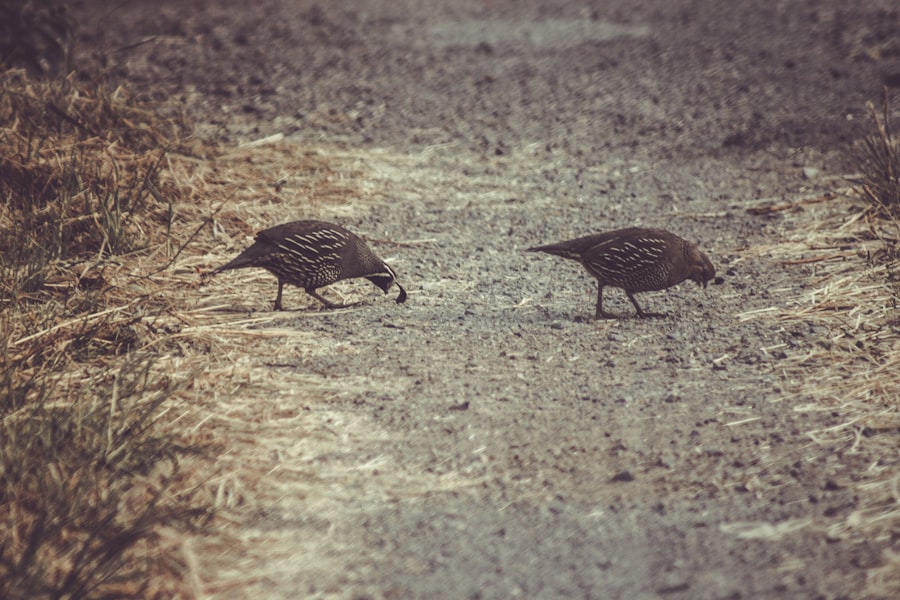
Button quail are generally skittish birds that prefer not to be handled by humans. However, with patience and gentle socialization, they can become more comfortable with human interaction over time. It’s important to approach button quail calmly and slowly, allowing them to become accustomed to your presence before attempting any handling.
When handling button quail, it’s important to support their body securely and avoid sudden movements that could startle them. It’s best to handle them close to the ground or within their enclosure to prevent injury from accidental falls. It’s also important to be mindful of their delicate bones and feathers when handling them, as they are small and fragile birds.
Socialization with humans can be encouraged through positive reinforcement training and offering treats as rewards for calm behavior. Spending time near their enclosure and speaking softly to them can also help build trust over time. It’s important to respect their boundaries and not force interaction if they are not comfortable.
Overall, button quail can become more tolerant of human interaction with patience and positive reinforcement. However, it’s important to remember that they are primarily observational pets rather than hands-on companions.
Common Behavioral Issues and Solutions
Button quail may exhibit certain behavioral issues in captivity that can be addressed with proper care and attention. One common issue is feather plucking or self-mutilation, which can be caused by stress, boredom, or health issues. Providing a stimulating environment with plenty of enrichment such as hiding spots, perches, and foraging opportunities can help prevent these behaviors. Additionally, addressing any underlying health issues through veterinary care is essential.
Another common behavioral issue is aggression between birds in the same enclosure. This can be caused by overcrowding or territorial disputes. Providing enough space and hiding spots within the enclosure can help reduce aggression by giving each bird a sense of security and personal space. If aggression persists, it may be necessary to separate the birds into smaller groups or individual enclosures.
Some button quail may also exhibit excessive vocalization or calling behavior, especially during breeding season. This is a natural behavior for these birds but can be disruptive in certain living situations. Providing distractions such as toys or rearranging the enclosure layout can help redirect their focus away from excessive calling.
Overall, addressing behavioral issues in button quail requires understanding their natural behaviors and providing an enriching environment that meets their physical and psychological needs. With proper care and attention, many behavioral issues can be prevented or resolved for happy and healthy button quail in captivity.
If you’re interested in keeping button quail, you may also want to explore the article on creating a farmhouse chicken coop on PoultryWizard. This resource provides valuable insights into designing a safe and comfortable living space for your quail, as well as tips for integrating them with other poultry. Check it out here.
FAQs
What are button quail?
Button quail, also known as Chinese painted quail, are small ground-dwelling birds native to Southeast Asia. They are popular as pets due to their small size and colorful plumage.
What do button quail eat?
Button quail are omnivorous and eat a variety of foods including seeds, insects, and small plants. In captivity, they can be fed a diet of commercial game bird feed, supplemented with fresh fruits and vegetables.
How do you keep button quail as pets?
Button quail are best kept in pairs or small groups in a spacious enclosure with plenty of hiding spots and substrate for scratching. They require a balanced diet, access to clean water, and regular cleaning of their enclosure.
What is the lifespan of button quail?
In captivity, button quail can live for 5-7 years with proper care and a suitable environment.
Are button quail noisy?
Button quail are relatively quiet birds, making soft chirping and peeping sounds. They are suitable for apartment living and are less likely to disturb neighbors compared to larger, more vocal bird species.
Meet Walter, the feathered-friend fanatic of Florida! Nestled in the sunshine state, Walter struts through life with his feathered companions, clucking his way to happiness. With a coop that’s fancier than a five-star hotel, he’s the Don Juan of the chicken world. When he’s not teaching his hens to do the cha-cha, you’ll find him in a heated debate with his prized rooster, Sir Clucks-a-Lot. Walter’s poultry passion is no yolk; he’s the sunny-side-up guy you never knew you needed in your flock of friends!

